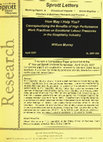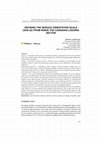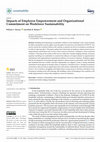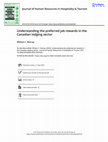Papers by William C Murray

The hospitality industry relies on front-line staff members to provide high quality service exper... more The hospitality industry relies on front-line staff members to provide high quality service experiences to encourage repeat business. Unlike the manufacturing industry that separates the production of goods from the delivery to customers, professionals in the hospitality industry realize that customers evaluate their "product" through perceived service quality levels (Ottenbacher & Howley, 2005). Although types of service may differ, industry operators and researchers agree that both customer satisfaction and service quality are critical prerequisites for customer retention (Cronin & Taylor, 1992). Consistent service quality demands a workforce with strong emotional display management skills; however, displays of unfelt feelings, or "acting", can create intense emotional strain for service providers. This paper will examine the emotional labour pressures experienced by service workers and outline theoretical mitigating influences provided by high performance work...

Tourism and hospitality management
Purpose – The purpose of this study is to validate and refine, as appropriate, the Service Orient... more Purpose – The purpose of this study is to validate and refine, as appropriate, the Service Orientation Scale in the unique context of the Canadian lodging sector, while exploring demographic differences expressed by respondents. Design – The study is based on Groves’ 34-item service orientation scale developed for the hospitality industry. Online self-administration questionnaires were completed by 348 hospitality employees. Methodology/Approach – Confirmatory factor analysis revealed extensive loading issues in Groves’ three-factor model, while also surfacing problems with item inclusion in the four-factor model presented by Kim et al. (2003). Subsequent exploratory factor analysis led to the creation of an improved 22-item service orientation scale (SOS-22). Findings – This research significantly refines the multidimensional employee service orientation scale into a scale that balances the detail of the dimensions with the parsimony of the scale design. The richness of the constru...
Venkatesh, 2005). Obviously, mobile phone is now integrated into our daily life. Indeed, accordin... more Venkatesh, 2005). Obviously, mobile phone is now integrated into our daily life. Indeed, according to International Data Corporation (IDC), the market reached 1.472 billion mobile phones sold in the world in 2017 (ZDNet, 2018). In addition, according to Statista, there was 4.77 billion mobile phone users worldwide in 2017 while the population was reaching 7.6 billion people, and there will be 5.07 billion mobile phone users worldwide by 2019 (Statista, 2018). The purpose of this study is then to pursue the investigation on the determining factors that make such people around the world are so using the mobile phone.
thought development one thinks of in higher education. Moving to this model disrupts an ongoing c... more thought development one thinks of in higher education. Moving to this model disrupts an ongoing context of their schools, framing faculty as simple assembly line producers and students as machines in need of programming. The richness and depth of

Sustainability
Building and maintaining a sustainable workforce in the hospitality sector, where demand for tale... more Building and maintaining a sustainable workforce in the hospitality sector, where demand for talent consistently exceeds supply across the globe, has only been exacerbated by COVID-19. The need to sustain this workforce behooves the industry to unpack core drivers of employee commitment in order to retain top talent. This paper explores how dimensions of employee empowerment increase organizational commitment and, in turn, reduce turnover intention—leading to a more sustained workforce. Drawing on the results of 346 surveys within the Canadian lodging industry, structural equation modeling was undertaken to examine the influence of empowerment on organizational commitment and organizational commitments influence on turnover intention. Findings suggest that the development of meaning through employee empowerment, particularly when the ideals and standards between workers and their organization are aligned, creates a strong emotional commitment which appears to strongly reduce an empl...
Collected Essays on Learning and Teaching, 2010
This study examines the differences that exist among various age cohorts attending a post-seconda... more This study examines the differences that exist among various age cohorts attending a post-secondary educational institution. Respondents were from the New Brunswick Community College's six separate campuses (n=251). Significant differences were found to exist predominantly around social and family issues. Although differences did appear based on age groupings, a small amount of variation appeared when compared with theoretical literature. The largest barrier to post-secondary education that existed, regardless of age, was the financial burden placed upon the learner.
Journal of Individual Employment Rights, 2007
A recent survey of the mental health of Canadian workers has suggested that the use of informatio... more A recent survey of the mental health of Canadian workers has suggested that the use of information and communications technologies (ICTs) such as wireless e-mail devices either maintains or increases employees' level of stress. This article explores this finding in more detail and concludes that individual coping strategies employed by workers to minimize the impact of stress are threatened by the ubiquitous communication delivered by ICTs. This in turn can have a negative impact on employee mental health and consequently may lead ...
Journal of Individual Employment Rights, 2007
A recent survey of the mental health of Canadian workers has suggested that the use of informatio... more A recent survey of the mental health of Canadian workers has suggested that the use of information and communications technologies (ICTs) such as wireless e-mail devices either maintains or increases employees' level of stress. This article explores this finding in more detail and concludes that individual coping strategies employed by workers to minimize the impact of stress are threatened by the ubiquitous communication delivered by ICTs. This in turn can have a negative impact on employee mental health and consequently may lead ...

International Journal of Hospitality & Tourism Administration, 2020
This study employs the Ten Factor Model in a longitudinal analysis to explore preferred job rewar... more This study employs the Ten Factor Model in a longitudinal analysis to explore preferred job rewards within the Canadian lodging industry. Data from three studies conducted between 1999 and 2016 were analyzed as individual cases in time and a longitudinal study over time. Two findings were made. First, the value of specific rewards and the motives to satisfy them shift over time, influenced by the relative intensity of needs and the context of external events. Second, while desired rewards shifted over time and context and respective values changed across studies, six rewards continually surfaced as top-ranked for employees. Additionally, rewards were explicitly connected with Herzberg’s Hygiene-Motivator Theory. Focusing on valued rewards that can influence job satisfaction or job dissatisfaction will be extremely useful to practitioners.

Journal of Human Resources in Hospitality & Tourism, 2020
This study examines motivations of employees in the Canadian lodging sector. Data was collected o... more This study examines motivations of employees in the Canadian lodging sector. Data was collected on the preferred job rewards expressed by employees ranging from front line workers to senior executives, as well as their perceptions of job satisfaction. Results were analyzed first at the aggregate level on their own and against extant literature, followed by a more segmented analysis by demographic characteristics of gender, age, income, and education. Results reveal mild but direct differences in motivational preferences based on gender, inferring the continued systemic gender imbalance that continues within the industry as supported by differences that exist by age, educational levels, job level, and income. Outcomes also highlight differences that appear in overall job satisfaction segmented by gender, age, position, and income level. Discussions include relating results to historical demographical job segmentation in the lodging industry, as well as relating the impact of life stage responsibilities and the influence of unmet needs on value propositions. All discussions highlight the contextual nature of motivational factors for lodging employees. Suggestions are made for industry practitioners about how best to invest scarce resources into talent management in order to contribute to more sustainable workforce practices.
Workplace Review, 2019
This study explores the motivations of Canadian hotel employees by measuring self-reported rankin... more This study explores the motivations of Canadian hotel employees by measuring self-reported rankings of preferred job rewards using the Ten Factor Model. Responses were compared specifically between job levels, as well as against perceived reward preferences of both peer and management groups. Results showed that job reward preferences varied by job level, from line employees to executives. Management groups demonstrated a keen insight of the rewards most valuable to their frontline employees; however, while peer groups seemed to understand the ordered preferences of job rewards, numerous misinterpretations of weighted value appeared.
Purpose -This paper aims to explore the challenges encountered by the hospitality and tourism ind... more Purpose -This paper aims to explore the challenges encountered by the hospitality and tourism industry in managing the labour challenges it faces presently and will face in the coming years. Although there are several issues at play, there are actions that industry members can take both internally and by advocating externally for change.
Journal of Individual Employment Rights, Jan 1, 2007
A recent survey of the mental health of Canadian workers has suggested that the use of informatio... more A recent survey of the mental health of Canadian workers has suggested that the use of information and communications technologies (ICTs) such as wireless e-mail devices either maintains or increases employees' level of stress. This article explores this finding in more detail and concludes that individual coping strategies employed by workers to minimize the impact of stress are threatened by the ubiquitous communication delivered by ICTs. This in turn can have a negative impact on employee mental health and consequently may lead ...
Journal of Individual Employment Rights, 2007
ABSTRACT: A recent survey of the mental health of Canadian workers has suggested that the use of ... more ABSTRACT: A recent survey of the mental health of Canadian workers has suggested that the use of information and communications technologies (ICTs) such as wireless e-mail devices either maintains or increases employees' level of stress. This article explores this finding in more detail and concludes that individual coping strategies employed by workers to minimize the impact of stress are threatened by the ubiquitous communication delivered by ICTs. This in turn can have a negative impact on employee mental health and ...







Uploads
Papers by William C Murray